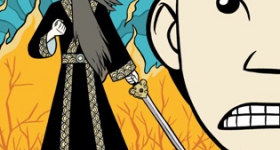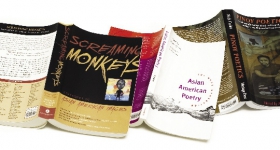Jeff Chang’s first book, Can’t Stop, Won’t Stop (2005), was, for me, slow reading. I would spend entire nights poring over a few pages. Problem was, progress was constantly thwarted by urgent detours to the Internet. How could I understand hip-hop’s Jamaican roots without watching Jimmy Cliff’s 1972 breakout film, The Harder They Come?
Chang is almost too effective at transporting readers into a specific time, place, and social formation. Every cultural object he examines becomes The Most Important Thing. For someone who has never felt particularly close to hip-hop, but whose formative years also spanned the 1980s and '90s, Chang’s history nonetheless read as if it were my history.
No surprise, then, that Chang’s newest book, Who We Be: The Colorization of America, was an equally edifying experience that also drew me in close. Spanning what has come to be called the “post-Civil Rights era,” its subject is no less than the career of multiculturalism over the past fifty years.
It’s an ambitious and unruly subject, one that immediately raises the question: How the hell do you tell a story about the last fifty years of race in America in one book? Just a few pages into Who We Be, one finds the narrative horizon quickly expanding to engulf everything. Throughout its 341 pages, one feels at risk of being tossed overboard into a churning ocean of context: a feeling intensified by Chang’s truly formidable range of knowledge. So it’s all the more impressive that Chang is able to connect with his readers -- this reader, at least -- on such a personal level. Who We Be reveals the unsettling backstory to our most closely guarded assumptions about race. As its title suggests, it wants to tell us something important about ourselves.
Chang has a talent for bringing you to eye-level with his subjects. Here he is on Jessica Hagedorn’s beatnik tween years in San Francisco, her mentor, the influential San Francisco poet Kenneth Rexroth, and the questions that sharpened her identity as an artist:
Hagedorn asked herself: Didn’t “Third World” signify something inferior? Why were her light-skinned Spanish relatives considered higher-class than her dark-skinned village-born grandmother? She had long discussions with Rexroth about race and American history. Was it true that Filipinos in the United States picked asparagus? That they had organized with Cesar Chavez? She wondered, how did people really see her?
Inhabiting his subjects’ interiorities not only makes them present to the reader, it actually makes sense as a narrative strategy. It allows Chang to cover a lot of historical and thematic ground through a kind of stream-of-consciousness. The effect is reinforced by prose set to a four-to-the-floor rhythm in which Chang sets up context in a sentence or clause, holds it aloft for a beat or two, then lands it on its feet right in front of you:
You might tag that wall. You might kick down that door. You might even pull off an Ali shock-the-world upset. But were you prepared for what came next?
The characters that fascinate Chang are the ones who display this sort of brashness; whose minds, like Hagedorn’s, are always searching, always trying to locate the line where they end and the world begins. And so we flit from Ishmael Reed and Al Young and their groundbreaking Yardbird writers (including Hagedorn, Frank Chin, Leslie Marmon Silko, June Jordan, and others), to Daniel Joseph Martinez and his confrontational art pieces on race, to the journalist José Antonio Vargas and his undocumented DREAMers. Chang’s question -- “were you prepared for what came next?” -- aptly sums up the double-bind that these figures consistently find themselves in. To spark an honest, open discussion about race, one needs to kick down doors -- but maybe not off their hinges. Where is the line beyond which you begin working against yourself?
In his preface, Chang uses the metaphor of an ocean wave to begin thinking through the two questions that organize his book: “How has the national culture changed over the past half-century that we could elect a Black president? And, just as important, how has it not changed?” The answers, he invites us to imagine, might resemble a wave: a discrete event that is the culmination of a global process “of forces generated in the Arctic or the Antarctic, rolling from the bottom of the ocean for hundreds of miles until they gather to hit…shallow reefs.” Put another way, “political change is the last manifestation of cultural shifts that have already occurred.” Obama’s election, in other words, was the result of a process that long predated and far exceeded the events of Election Night, 2008.
But what is the “nation?” What is “culture?” What could possibly pass under the name “national culture”? Does “national culture” begin and end at the border? Does race? These are the kinds of questions that wars are fought over, and, accordingly, the bulk of Chang’s book focuses on the institutional histories and the most prominent players in the endless culture wars that have erupted -- or formed, we might say, like a wave -- since the 1960s.
The book opens with the cartoonist Morrie Turner, whose strip, Wee Pals, debuted in 1965 and was the first nationally syndicated strip with a multiracial cast of characters. Several of Who We Be’s chapters are punctuated by Turner’s strips, which feature a group of kids whose understandings and misunderstandings of racial politics tend to bring them together rather than divide them. We eventually realize that Chang uses this format to offer a representation of what he calls “the new cultural majority”: a generation that has grown up in a “colorized” America, where race has been -- at least on the surface -- more a matter of culture than politics.
In reconstructing the long, undulating process of “colorization,” Chang devotes most of his attention to the galleries and advertising boardrooms of New York City and Los Angeles. From the scandal of Donald Newman’s 1979 exhibition at the Artists Space, entitled “The Nigger Drawings,” to David Ross’s inaugural Biennial as the Director of the Whitney Museum of American Art in 1993, Chang shows us how the art world’s fraught racial politics alienated it at various moments from an intolerant right and a smug left. The stories he tells of the postwar rise of race-based market segmentation, the United Colors of Benetton’s facile aestheticization of multiculturalism, and Shepard Fairey’s pro-Obama street art remind us of how deeply the machinations of the market have shaped not only our attitudes towards race, but also our aspirations for the future.

Photo of the author courtesy of The Lavin Agency
This is as much a book about the assimilating power of globalization as it is about race and multiculturalism. In this regard, Chang’s most significant interlocutor is the social critic Mark Fisher, whose concept of “capitalist realism” makes frequent appearances. Fisher’s concept refers to the totalizing sense that there is no outside of the capitalist system; there are no ideals, no Utopias -- multicultural or otherwise -- that are realistically worth pursuing. While the precise nature of the “wave” that Chang is trying to describe never quite draws into focus, it does become clear that, in his view, the main thing that has changed between Brown v. Board of Education and Obama’s election is that race and multiculturalism have largely been taken out of politics and installed in the market. If race has indeed been transplanted into the realm of “culture,” then that is the price of the ticket. It’s along these lines that “neoliberalism” -- the ideology of the market ruling all aspects of personal and political life -- sometimes imperceptibly replaces race as Chang’s object of analysis.
Who We Be comes at a key moment in the history of American racial discourse. In the wake of the murders of Trayvon Martin and Michael Brown, of Ta-Nehisi Coates’ reinvigoration of the slavery reparations debate, and of Michelle Alexander’s unveiling of the criminal justice system’s relentless pursuit of young black men, recent history has seen the reassertion of race as the predominant category shaping contemporary American life -- something we have never gotten beyond, despite the ubiquitous and shallow rhetoric of “postracial America.” These interventions, moreover, arrive in the wake of the Occupy movement’s enormously successful reassertion of class and income inequality as the predominant determinants of our present moment. It also brings Chang into recent discussions about racialization in an era that, in the still-relevant words of Richard Nixon, “recognizes [the fact that the whole problem is really the Blacks] while appearing not to”: a discussion perhaps most prominently led by Alexander and her book The New Jim Crow, and that has been taken up by writers like Kenneth Warren, Eduardo Bonilla-Silva, David Theo Goldberg, Ramon Saldívar, Stephen Hong Sohn, Hazel Rose Markus, and Paula M. L. Moya, among many others.
Hyphen readers will notice that it takes a good 72 pages for the words “Asian America” to appear, and 128 for Chang to engage directly with Asian American culture. This is of course the danger of writing a book about identity politics. There’s always another group, another context or cultural object that’s The Most Important Thing, that needs to be included in order for the account to be in any sense complete. We could exhaust ourselves nitpicking Who We Be. That said, Chang does gloss over events that have been central not only to the Asian American experience, but to the story of multiculturalism that he is trying to tell. We needed to hear more about the Third Worldist student movements at UC Berkeley and San Francisco State University that gave birth to Ethnic Studies programs, and in many ways to identity politics; more pages are spent on the admittedly important, though far less impactful student battles against Western Culture core requirements at Stanford in the 1980s. We are treated to only a few paragraphs on the 1965 Immigration and Nationality Act, which altered the racial makeup of the U.S. so dramatically that, nearly half a century on, we are still struggling to understand the extent of its impact.
Aside from these oversights of content, Chang’s reassertion of race comes at a theoretical cost. It’s difficult to tell what effect other categories -- gender and sexuality in particular, but also class -- might have had on the story of race Chang is trying to tell. The filmmaker Marlon Riggs is mentioned, as is Robert Mappelthorpe, but their controversial depictions of black male bodies are reduced to mere provocations of the conservative right. But how does queerness change how we see race? How does race change how we see queerness? And to Chang’s own organizing questions, we might respond: Could we have been ready for Obama without first being ready for Hillary?
By the end of Who We Be, we are also left wondering what happened to the “dub history” -- a kind of history that Chang defines in Can’t Stop, Won’t Stop as a “people’s history” -- promised in the preface. The history of colorization Chang presents is mediated by an elite strata of artists, culture producers, and institutional executives: “image- and idea-makers,” as he calls them. But what of culture’s consumers? What of “the people?” It’s their experiences that Chang so powerfully captures in Can’t Stop, Won’t Stop. In that book it’s their constant morphing back-and-forth from consumers to “image- and idea-makers” that makes the story of hip-hop so compelling and personal.
These unresolved questions diminish the impact of Chang’s poetic conclusion, in which he brings to life Turner’s Wee Pals and puts them in front of Byron Kim’s installation Synecdoche, a large-scale mosaic of canvases painted in various skin-tones:
…each of the six [kids] raise their open hands, seeing the colors of their fingers and the colors of the painting through them, searching for themselves and for each other, seeing together anew, as if they are reaching out to touch the future.
It’s a beautiful scene, one that powerfully imbues art and youth with the power of change. However, this younger generation, the “new cultural majority,” recalls an all-too-familiar multicultural Utopianism whose representations range from Benetton’s vapid flattening of difference to the incisive and provocative works of the 1993 Whitney Biennial, where Kim’s piece debuted. It’s unclear where on this spectrum Chang intends this scene to land. More questions emerge. Why, at the end of a book that so effectively dismantles the racial hopefulness of Obama’s election, that reminds us repeatedly that while everything appears to have changed, very little has actually changed, should we put our hope in a “new cultural majority” whose members also include the 28-year-old Darren Wilson and 31-year-old George Zimmerman?
By repurposing Turner’s 1960s-era vision, Chang essentially asks us to have faith that the system will produce its own solution, even if it requires a generation to die off. But the questions I wish had framed this searching, passionate, and almost endlessly interesting book, are these: Is Turner’s vision still relevant? Does race confine us to capitalist realism, or might it in some way -- even through its negation -- show us a way out?
What comes next?










Comments